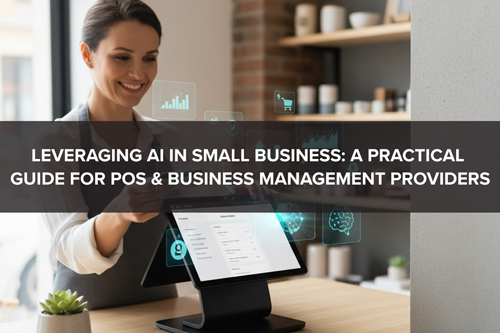 Artificial Intelligence is no longer a futuristic add-on. It’s quickly becoming a core driver of operational efficiency, customer engagement, and profitability. For technology solutions providers who deliver Point of Sale (POS) and business management platforms to retail and restaurant merchants, AI represents a unique opportunity to deliver measurable value across the merchant lifecycle.
Artificial Intelligence is no longer a futuristic add-on. It’s quickly becoming a core driver of operational efficiency, customer engagement, and profitability. For technology solutions providers who deliver Point of Sale (POS) and business management platforms to retail and restaurant merchants, AI represents a unique opportunity to deliver measurable value across the merchant lifecycle.
Below are a few actionable steps from entry-level adoption for non-technical users to advanced implementations for engineering teams.
1. Entry-Level AI Applications for Non-Technical Users
If your merchants aren’t tech-savvy, AI can still be embedded into your offerings in ways that feel intuitive and easy.
a. Smart Sales Insights
What it is: AI analyzes historical sales data to predict best-selling items, seasonal trends, and inventory needs.
How to apply: Offer a dashboard widget that automatically suggests:
Which menu items to promote this week
When to reorder popular stock
Price adjustment recommendations
b. Automated Customer Communication
What it is: AI-powered messaging tools can send targeted, personalized offers to customers.
How to apply: Integrate with SMS/email systems that:
Send birthday discounts
Promote slow-moving inventory
Remind customers of loyalty points
c. Labor Scheduling Assistance
What it is: AI forecasts peak business hours and recommends optimal staffing.
How to apply: Provide a calendar tool that:
Highlights over- or under-staffed shifts
Suggests shift changes based on traffic trends
2. Mid-Level AI Solutions for Tech-Savvy Business Owners
For merchants comfortable with technology, AI can dig deeper into analytics and personalization.
a. Demand Forecasting
Use AI models trained on POS data, weather forecasts, and local events to predict sales volume.
Output actionable recommendations for inventory orders and prep schedules.
b. Fraud & Loss Prevention
Integrate machine learning to detect unusual transaction patterns such as:
Excessive voids/refunds
Suspicious high-ticket orders
Staff behavior anomalies
Provide real-time alerts and easy drill-down reports.
c. AI-Enhanced Menu or Product Optimization
Use customer purchase data to recommend:
Menu redesign for better upsells
Placement of high-margin products on screens or menus
3. Advanced AI Integration for Engineering Teams
For providers with in-house engineering resources, AI can be embedded deeply into your product architecture.
a. Predictive Maintenance for POS Hardware
Deploy machine learning models that analyze hardware logs to predict failures (e.g., receipt printers, card readers).
Proactively notify merchants before breakdowns occur.
b. Voice & Vision AI
Voice AI: Enable hands-free POS interactions for busy kitchens or counter staff.
Vision AI: Integrate with cameras for:
Real-time line length monitoring
Kitchen order progress tracking
Shelf stock level detection
c. Real-Time Recommendation Engines
Develop algorithms that personalize upselling at the register or kiosk:
“Customers who bought this also bought…”
Cross-sell based on time of day, weather, or customer profile
4. Implementation Steps for All Levels
Whether your clients are small café owners or multi-location retailers, these steps help ensure smooth AI adoption:
Start with a Clear Problem
Avoid “AI for AI’s sake.” Identify pain points:
Long checkout lines
Inventory waste
Low customer return rates
Choose the Right Data Sources
AI effectiveness depends on data quality:
POS transaction history
Inventory logs
Customer loyalty records
External data (events, weather, market trends)
Integrate Seamlessly
AI features should feel like natural extensions of your POS platform:
Embed in dashboards
Offer actionable “one-click” recommendations
Minimize training requirements
Test, Measure, Refine
Roll out AI features to a subset of merchants first.
Gather feedback, measure ROI, and optimize algorithms.
5. Future Opportunities
AI in POS and business management is just getting started. Areas to watch include:
Generative AI for automated marketing content (menus, social posts)
AI-driven pricing models for dynamic price adjustments
Customer sentiment analysis from online reviews and surveys
Integrations with IoT devices for smart kitchens and stores
Bottom Line:
For technology solutions providers in retail and hospitality, AI is a multiplier. By layering AI on top of POS and business management systems, you can offer merchants not just tools, but tangible, data-driven ways to grow sales, cut waste, and improve customer experience.



